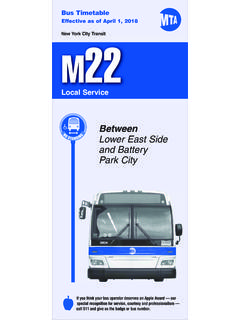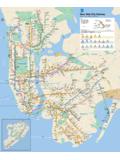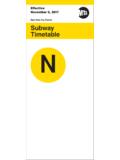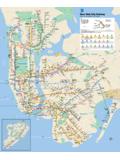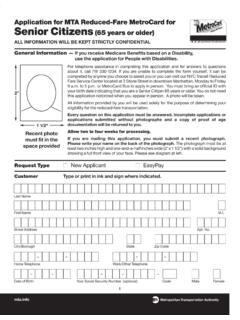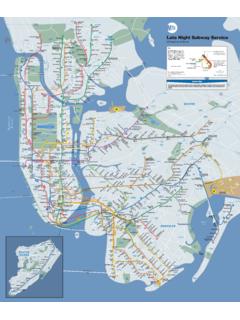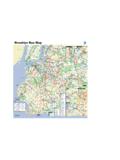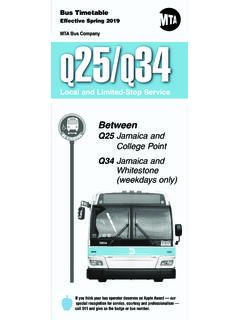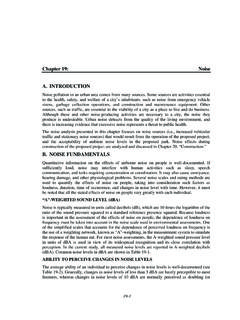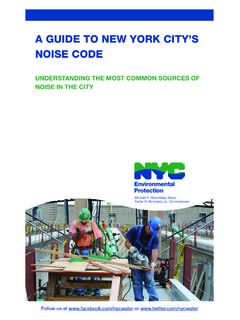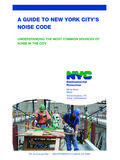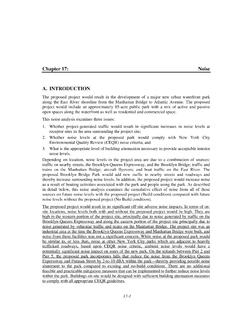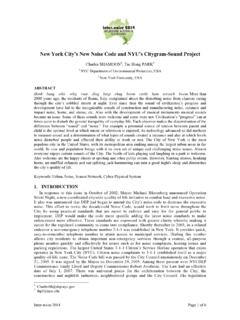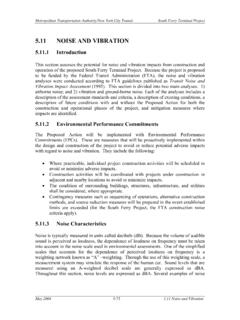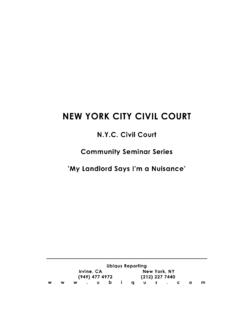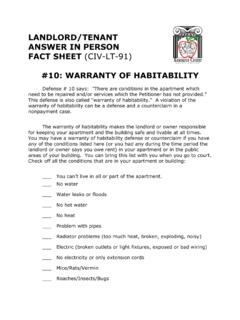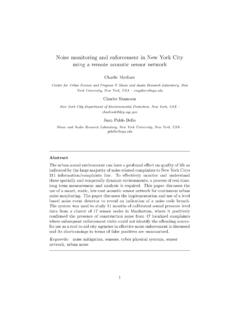Transcription of Chapter 13 Noise and Vibration 09-23-04 - MTA
1 MTA New york city Transit Fulton Street Transit Center FEIS and Section 4(f) Evaluation October 2004 Noise and Vibration 13-1 Chapter 13: Noise AND Vibration INTRODUCTION CONTEXT & KEY ISSUES This Chapter considers potential impacts from the Proposed Action upon ambient Noise and ground-borne Vibration levels. Airborne Noise impacts are compared to both pre-September 11 Noise levels and existing 2003 Noise levels. Vibration levels from each of the analysis years 2005/2006 (Construction), 2008 (Initial Operation), and 2025 (Full Operation) - are analyzed for potential impacts to sensitive receptors, which includes those defined by Federal Transit Administration (FTA) standards.
2 Within the immediate area of the Existing Complex and in Lower Manhattan in general, the current ambient Noise levels are generated by: heavy automobile, city bus, and truck traffic volumes, emergency vehicle sirens, and Noise generating construction equipment and outdoor events for example, large gatherings and concerts. Although current Noise levels since the events of September 11 have been reduced, monitoring data still indicate that 2003 Noise levels remain high. The reductions in Noise levels since September 11 are directly related to reductions in office workers, visitors and other activities associated with the central business district in Lower Manhattan.
3 This Chapter considers the potential Noise and Vibration impacts related to increases or decreases in traffic and from the construction and operation of the Proposed Action within the study area. Increases or decreases of on-street traffic are analyzed because traffic is a predominant contributor to ambient (existing and pre-September 11 background) Noise levels at the project site. The construction of the Proposed Action is expected to produce temporary Noise and Vibration impacts. The Noise and Vibration levels associated with operations of the Proposed Action are also analyzed in this Chapter and are compared to the existing and pre-September 11 Noise levels to evaluate potential Noise and Vibration impacts.
4 CONCLUSIONS ANALYSIS YEAR 2005/2006 Under the No Action Alternative, existing commercial land uses in the study area would continue and the Existing Complex would be maintained in its current state. No major construction activities related to the Fulton Street Transit Center (FSTC) are anticipated. Construction activities associated with other Lower Manhattan Recovery Projects, with the exception of South Ferry Subway Terminal, would be ongoing in 2005/2006. Minor maintenance and rehabilitation activities associated with the Existing Complex could occur, including typical station and transit infrastructure maintenance and repair during this analysis year.
5 As a result, there would be no adverse impacts from mobile (construction traffic) or stationary (including movable and stationary construction equipment) sources attributable to the No Action Alternative upon Noise conditions or Vibration levels in the study area. Impacts from Mobile Sources With other Lower Manhattan Federal Recovery Projects, as part of the background condition, Alternative 9 and Alternative 10 - the Preferred Alternative would result in decreases or no change in traffic at two (2) of the receptor locations due to street closures for activities proposed under the FSTC when compared with 2003 existing conditions.
6 Additional traffic would be generated at the eight (8) other locations, seven (7) of which would result in an imperceptible increase of less than two (2) dBA during the AM peak traffic hour. The Century 21 Department Store - Cortlandt Street entrance (Site 4) would experience a Passenger Car Equivalent (PCE) (traffic volume) increase of almost 400 percent resulting in a substantial increase of dBAs during the AM peak hour. Using a three (3) dBA increase as the MTA New york city Transit Fulton Street Transit Center FEIS and Section 4(f) Evaluation October 2004 Noise and Vibration 13-2 discernable threshold, there would be adverse airborne Noise impacts from mobile sources at Site 4 during the AM peak hour.
7 Compared to pre-September 11 conditions, the FSTC would result in decreases in traffic at four (4) of the receptor locations, two (2) of which are due to street closures for activities proposed under the FSTC. Additional traffic would be generated at the five (5) other locations, all of which would result in an imperceptible increase of up to dBA during the AM peak traffic hour. Using a three (3) dBA increase as the discernable threshold, there would be no adverse airborne Noise impacts from mobile sources at any of the nine (9) locations during the AM peak hour.
8 Impacts from Stationary Sources Existing conditions reflect an atypical recovery condition. Noise levels were therefore also compared against pre-September 11 levels which reflect a more typical condition for Lower Manhattan. Peak one (1)-hour Leq, eight (8)-hour Leq, and 30-day Ldn were calculated at each of nine (9) sites. The resultant Noise level histograms are presented in Appendix J, Part III, Stationary Sources Sections. The maximum one (1)-hour, eight (8)-hour, and 30-day Noise levels are summarized and presented in Tables 13-10 through 13-13 below.
9 As presented in Table 13-10, peak one (1)-hour Noise levels would exceed FTA criteria of 90 dBA for residences and hotels and 100 dBA for office and commercial at Sites 3, 6, 8 and 9. The eight (8)-hour Noise levels would exceed FTA criteria of 80 dBA (for residences and churches) and 85 dBA (office/commercial) at seven (7) of the nine (9) sites. It is noted that the calculated peak-hour and eight (8)-hour Noise levels are the maximum expected Noise levels at each of the receptor locations. In addition, expected Noise levels would only occur during peak construction activities, which are limited to certain time periods and last for short periods of time, hours or days, over the entire construction duration.
10 The 30-day Ldn levels would exceed FTA criteria at Sites 2, 3, 6, 8 and 9 using the Minimum Distance Method. The Minimum Distance Method presents the most conservative analysis in determining the closest point that pieces of moveable equipment could be located to the receptor. (Stationary equipment would, in fact, be placed as far away as possible within the work zone). In calculating Noise levels using the Minimum Distance Method, several of the Noise receptors were assumed to be located at relatively short distances from the Noise generating source.
